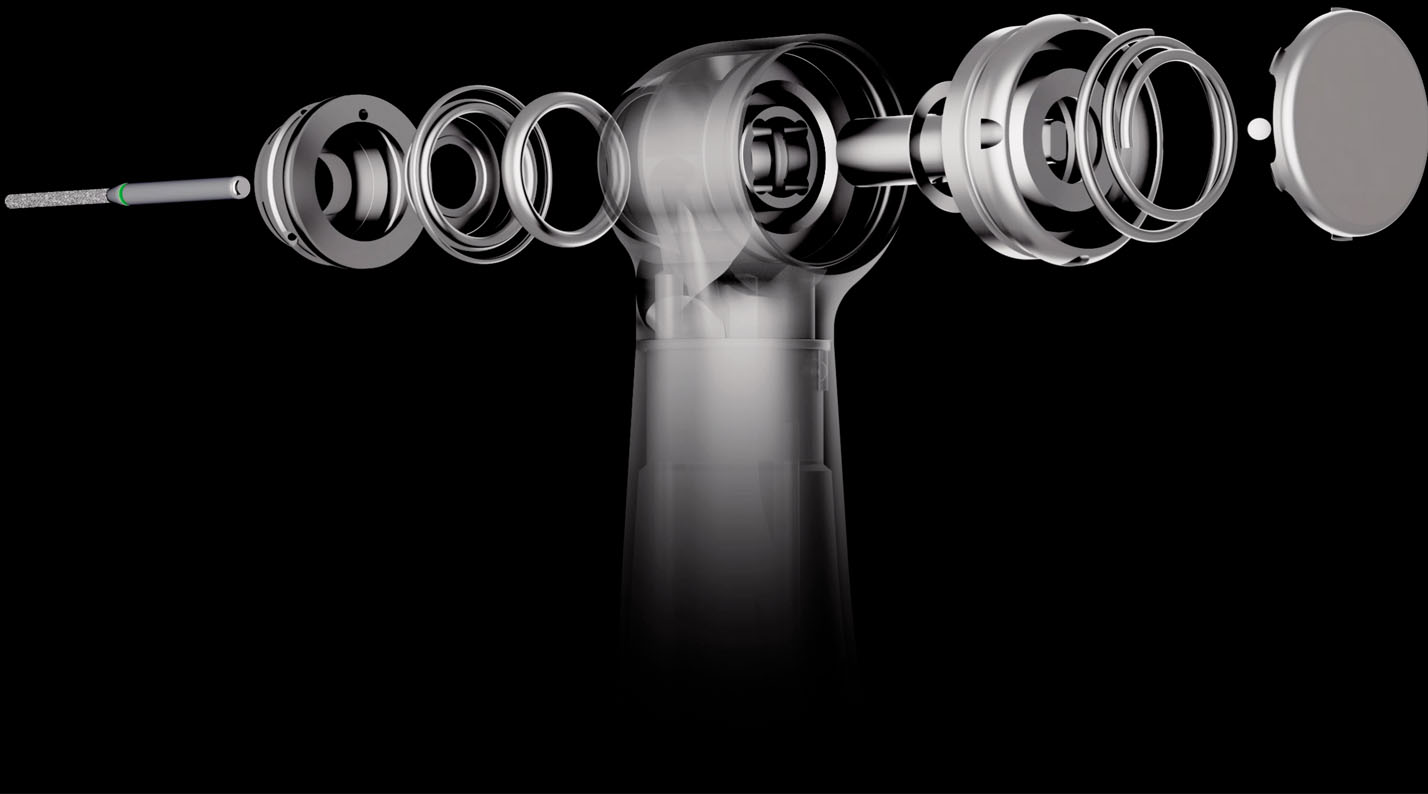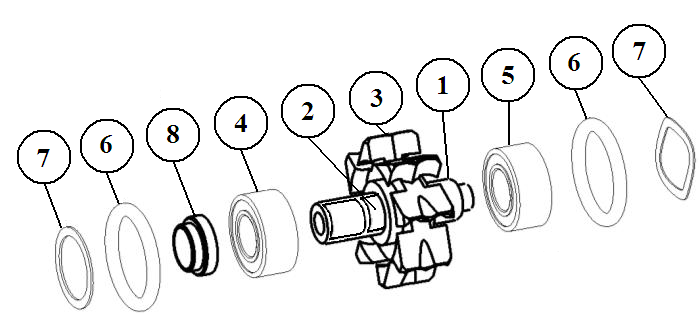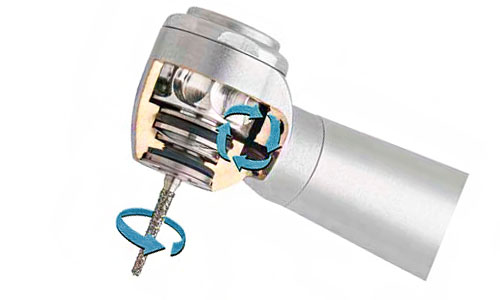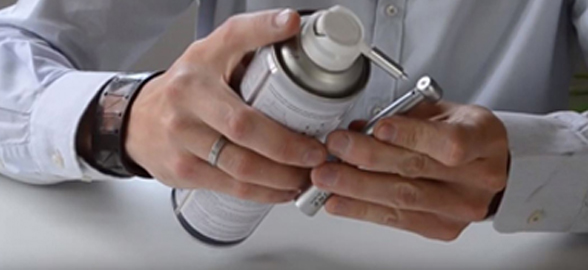Buying rotary dental equipment is an easy task when you are used to buying the same equipment every time. But, for example, if we think about dental turbines, what happens when it comes to comparing these machines and buying the one that best suits our needs? The task becomes more difficult!
But pay attention, because in today's article we will tell you everything you need to take into account to buy an economical dental turbine that is both durable and effective for your treatments in the dental clinic.

How does a dental turbine work?
It is essential to know how a dental turbine works in order to know where the most problems can occur when working with them.
A dental turbine is a rotary instrument that is driven by air compression directly through the dental unit's hose via a coupling. Among all rotary instruments, it has the highest speed (from 100,000 to 500,000), but the lowest torque. The working speed is about half of the free rotation speed.
As a result of the speed, significant frictional heat is produced by all the driving force on the spindle rotor, which is why it comes integrated with an air and water irrigation system to cool it.
Dental turbines are suitable for work that requires greater resistance to treatment, removing hard tooth tissue such as enamel or prosthetic material. Multiplier contra-angle handpieces can also be used, but the turbine will be more effective.
What are the parts of a dental turbine?
The most important part of the turbine is the rotor, which is the component that does all the work. The standard parts that make it up are shown in the following diagram:

- Spindle: at the centre of the turbine, the shaft that rotates.
- Mandrel: is inside the spindle. This is a hollow tube into which the burr is fitted.
- Impeller: located in the middle (front to back) of the spindle (pressed in here). It is the impeller that captures the air that makes the turbine rotate.
- Front bearing.
- Rear bearing: On each side of the impeller there are bearings, which allow the spindle to rotate by reducing friction.
- O-ring seals: ensure a tight fit inside the turbine head, also reducing vibration.
- Washer / wave washers: are only used on handpieces with automatic chuck to provide lateral tension, keeping the turbine pressed against the cap to facilitate chuck actuation.
- Slinger: is fitted to the front bearing to protect the bearing against dust and contamination.
What should you consider when buying a dental turbine?

When choosing a dental turbine, you should take into account the following variables, in order to choose the one that best suits your needs:
An example of a dental turbine with mini head is la Eco Line de MK Dent, ideal for precision work, also available with standard head.
In addition, there are turbines with fiber optic lighting and autogenerated light, which provides light at any time.

So which turbine should I choose?
The choice should be based on choosing the turbine that best suits the needs of each case or the treatments that are most often performed in each dental clinic, that is, you should take into account the use that will be given to it, the expected time of use, maintenance or type of treatments among other factors.
To make your work a little easier and not go crazy comparing thousands of turbines, below we will show you a selection divided by range with their main characteristics, so you can quickly gauge which one is best suited to your daily practice.
High-end dental turbines:
Mid-range dental turbines (less than €500):
ECO LINE turbine with light from Mk-dent
This German-made Mk-dent turbine is available in Kavo Multiflex, Midewst 4, Kavo, W&H, NSK and Borden connections, with or without light and mini or normal head. Low noise level, 3 or 4 spray holes, Available with compact optical bar, ceramic bearings and anti-return system.
Available with compact optical bar, ceramic bearings and anti-return system.Features:
- Head angle for better visibility and better access to molar areas.
- Ceramic bearings that guarantee vibration-free rolling and greater wear resistance.
- Low noise level.
- Pleasant touch and better grip.
- Formed by a carbon fiber handle.
- 3 or 4 separate air and water sprays.
- Prevents cross contamination.
- With or without light.
- Guarantees perfect hygiene.
- Available in different connections, from mini head with light or without light and standard head with light or without light.
ForceSilence 6000 turbine with Bader light
Multiflex connection, Triple spray, optimal cooling. Ceramic bearings. Approximate speed 300,000 rpm. Bur change by button and non-return valve.
Features:
- Fiber optic system
- LED of 25,000 lux.
- Triple spray, achieves optimal cooling at any time and situation
- Ceramic bearings, extends the useful life of the instrument
- Greater lightness and less noise.
- Maximum speed of up to 300,000 rpm.
- Working pressure 2.2 to 2.8 bars.
- Sterilizable in autoclave at 135 º C.
- Multiflex® connection from Kavo.
- Push-Button System: Changing burrs using a button.
Bora turbine with Bien-Air light
An incredibly light and precise instrument, classy, competitive and resistant. Incredibly powerful, robust and reliable, Bora turbines incorporate the best of Bien-Air technology.
Features:
- Intense adjustable light
- Reduced head made entirely of stainless steel.
- 4 separate air and water sprays
- Prevents cross contamination thanks to the water non-return valve.
- Fast and rotating Multiflex LED coupling for quick connection
- Includes the Cool Touch button.
- Guarantees perfect hygiene.
- Ceramic ball bearings that reduce noise levels and vibrations, resistant to wear.
Cheaper dental turbines (less than €250):
Lotus 302 2PBQ-K: Dental Turbine with LED Light - Multiflex Connection - Nexo
Nexo is the brand specializing in rotary instruments that stands out for its ease of use and the quality and finish of its parts. They are highly ergonomic for the dentist, firstly due to their design and grip that facilitate handling inside the mouth and then due to their weight, because they are very light. In use they are very stable and their vibration is low.
Features:
- Made of high quality steel and coated with a resin to avoid scratches and the rigors of daily use.
- 3 spray outlets
- Multiflex connection
- It has a comfortable button, you only have to apply a light pressure.
- Compatible with Kavo system.
- With LED light.
- The instrument change is quick and comfortable.
Rumar Rm ECO T2 Turbine without light
The Ecoline Eco T2 turbine is a turbine with the best quality-price ratio and attractive design that includes a torque head with greater force that allows greater durability of the piece.
Characteristics:
- Anti-return system.
- Direct connection Midwest 4
- With ceramic bearings
- Power: 21W.
- Spin speed: Power head 340,000 rpm.
- Noise level: 70 dBA.
- Without light.
- Chrome coating.
- The best option for students or as a second turbine in a clinic.
- 6-month warranty.
BienAir Black Pearl Eco Turbine without light
The Black Pearl Eco offers the quality of a BienAir instrument at a very good price. It has a comfortable push button, a separate air/water spray and connects directly to a 3 or 4 hole hose. Thanks to its medium-sized head, it is the versatile turbine par excellence.
Features:
- No imbalance or vibrations.
- Power, lightness, manageability.
- It has a comfortable button, you only have to apply a light pressure.
- With adjustment by plates and with clamps.
- 1 separate air/water spray.
- It connects directly to a 3 or 4-hole hose.
- Thanks to its medium-sized head, it is the versatile turbine par excellence.
- The instrument change is quick and comfortable.
Here are several tips for the maintenance of rotary instruments so that you can keep your turbine and other devices in perfect condition for many years!












